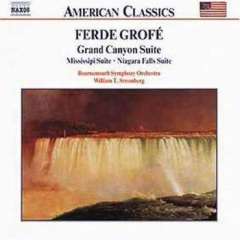Ferde Grofé - Grand Canyon Suite • Mississipi Suite • Niagara Falls Suite (1999)
Ferde Grofé - Grand Canyon Suite • Mississipi Suite • Niagara Falls Suite (1999)

Mississippi Suite (1925) 1. I Father of Waters 00:03:17 2. II Huckleberry Finn 00:02:22 3. III Old Creole Days 00:03:04 4. IV Mardi Gras 00:04:52 Grand Canyon Suite (1931) 5. I Sunrise 00:05:27 6. II The Painted Desert 00:05:21 7. III On the Trail 00:07:39 8. IV Sunset 00:05:10 9. V Cloudburst 00:08:22 Niagara Falls Suite (1960/61) 10. I Thunder of the Waters 00:03:35 11. II Devil's Hole Massacre 00:04:29 12. III Honeymooners 00:04:25 13. IV Power of Niagara 00:09:42 Bournemouth Symphony Orchestra William Stromberg (сonductor)
Ferde Grofé was born Ferdinand Rudolph von Grofé in New York City on 27th March 1892. His parents were of French Huguenot extraction, and both were very musical. His father was a baritone and actor, whilst his mother was a cellist and music teacher. Other members of his family were also involved in music, particularly in Los Angeles, to where the family moved shortly after Ferde’s birth. Ferde studied the piano, violin and harmony with his mother and the viola with his grandfather. He attended Los Angeles City Schools, and later St. Vincent’s College, the present Loyola University. His father died in 1899, and he then joined his mother in Germany, where she studied at Leipzig University for three years. Upon their return to Los Angeles, Madame Grofé opened a music studio. Ferde left home in 1906 and undertook many jobs, meanwhile studying the violin and piano in his spare time. From 1908 onwards he began to take casual musical engagements, and in 1909 joined the Los Angeles Symphony Orchestra, playing the viola, a post he held for ten years.
In 1917 he joined Paul Whiteman’s Orchestra as pianist, arranger, assistant conductor and librarian, and in 1924 he orchestrated Gershwin’s Rhapsody in Blue, which brought him to public notice. He now undertook the composition of original works, of which there are three on this disc. In 1932 he joined the NBC as staff conductor, and in 1937 he conducted two concerts of the New York Philharmonic. In 1939 he joined the faculty of the Juilliard School, teaching orchestration and composition. Over the next thirty years, he continued to compose, producing film scores, jazz suites, and further nature suites, deriving much of his inspiration from the natural beauties of North America. He died on 3rd April 1972 in Santa Monica, California following a series of heart attacks.
The Mississippi Suite recalls the exploits of Mark Twain’s books, ‘Tom Sawyer’ and ‘Huckleberry Finn’, the latter by name in the second movement. The subjects are described fairly graphically in the booklet, and are supposed to represent the flowing grandeur of the great river. The movements are Father of Waters, Huckleberry Finn, Old Creole Days and Mardi Gras. I will not comment further on the music style, except to say that in all the pieces it is rated with a B class movie, and although well played by the Bournemouth Symphony Orchestra, this does little to overcome the "travelogue" or "Western" leaning of these works. I do not have surround sound, but must admit to being grateful for only two speakers instead of four!
The Grand Canyon Suite was derived from his time in roaming the desert and mountain country as an itinerant pianist and is in five sections: Sunrise, The Painted Desert, On the Trail, Sunset and Cloudburst. The middle section is the well-known clip-clop one of the wagon train, but really the subject matter is so trite and the presentation so banal as to be not worthy of criticism. This section is also notable for black and white pictures of Monument Valley, Utah, which are presented at one per movement, and these are poor at that! I am sure that more could be achieved with DVD, especially as the one accompanying On the Trail appears as a series of dots. Incidentally, Toscanini described Cloudburst as one of the most vivid and terrifying of musical pictures; had he heard The Rite of Spring then? (surely so as it was performed first in 1913).
Niagara Falls Suite is a relatively late work, and was commissioned from the New York State Power Authority to commemorate the opening of the largest power plant at Niagara Falls. The Robert Moses Power Plant was opened on 10th February 1961, with Ferde Grofé there to conduct the Buffalo Philharmonic in the first performance. The composition is in four sections, Thunder of the Waters, Devil’s Hole Massacre, Honeymooners and Power of Niagara. The first movement has a drum roll showing the thunder and a black and white picture of the falls and mist. The second movement recalls the massacre of 350 British settlers from a train of 25 wagons, with a picture of a notice describing this outside a large cavern. The third movement is honeyed in the extreme and Victorian in its composition, with a picture of a lake; this reminded me of Ketèlbey in his Bells across the Meadow. The final movement again gives memories of Charles Chaplin’s film ‘City Lights’ with its busy music representing bustling workers and a picture of old buildings near some waterfalls (but not Niagara?)
Throughout, the playing of the Bournemouth Symphony Orchestra is exemplary, and the recorded sound is more than satisfactory. However, it would be unfair to say that they are unduly challenged and the interpretation is probably as good as one can expect. A pity about the visual aspect though; it could have been much more lifelike and inventive. The booklet is informative and descriptive of the music. ---John Portwood, www.musicweb-international.com
download: uploaded anonfiles yandex 4shared solidfiles mediafire mega filecloudio binge
Last Updated (Thursday, 05 December 2013 11:17)








